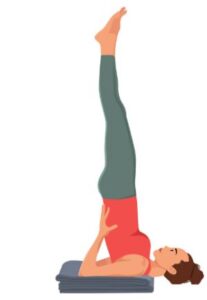What does it mean?

Figure: Steps of doing Sarvangasana
(Source: Nagammanavar & Natekar, 2020)
The term is taken from the Sanskrit language. The breakdown of the word Sarvangasana brings out three simple words, Sarv, Anga, and Asana (Nagammanavar & Natekar, 2020). Here Sarva means entire, anga means the body parts, and asana is the yoga posture. Another name of this asana is the Shoulder stand yoga pose. The simplification of the word brings out the meaning that, this yogic posture involves the entire body parts.
Perks of practicing Sarvangasana

Figure: Sarvangasana
This yogic posture involves the entire body. Thus it helps in improving the blood circulation process of the entire body. The efficient practice of this yoga helps in reaching oxygen-rich blood to the lungs, improving lungs efficiency (Nagammanavar & Natekar, 2020). Lack of proper blood circulation, over a period of time, can depreciate the efficacy of the thyroid gland, which is located in the neck region. Sarvangasana ensures the proper flow of oxygen-rich blood to the neck region, which enables the efficacy of the thyroid gland. Moreover, supplying oxygen-rich blood to the upper portion of the body helps in improving blood flow to the brain, thus calming down the mental stress and providing proper relaxation to the mind (Nagammanavar & Natekar, 2020). Hence, it is good for patients suffering from insomnia. The supply of oxygen-rich blood to the brain is also effective in reducing hair fall. Regular practice of this yoga helps in curing the genital organs, as well as it helps to cure the patients suffering from constipation.
Points to be noted while practicing Sarvangasana
Patients suffering from high blood pressure, menstrual problems, spinal cord injury should not practice this yoga. Pregnant women should take the advice of their physician or the yoga instructor before practicing this yoga (Prusty & Sahu, 2020). The yoga instructors also suggest that the patients suffering from thyroid gland disorders and shoulder injuries should avoid this yoga, as yoga is fully dependent upon the shoulders. The practitioners should practice yoga for not more than 2 minutes. The yoga pose should not be practiced more than the limited time and should not be repeated (Prusty & Sahu, 2020). While raising the legs, the practitioners should maintain deep inhalations and exhalations. Being careless while doing yoga, can cause harm to the neck and shoulder muscles. The trainers do not suggest that beginners try this complex pose.
References
Nagammanavar, R. Y., & Natekar, D. S. (2020). Importance of Yoga during Adolescence Period. EXECUTIVE EDITOR, 11(9), 84. Retrieved from http://www.ijphrd.com/scripts/IJPHRD_Sept.2020_final.pdf#page=90
Prusty, S. K., & Sahu, P. K. (2020). A Survey on Efficacy of BKS Iyenger Yoga for Cough. European Journal of Molecular & Clinical Medicine, 7(11), 683-696. Retrieved from https://www.fogsi.org/wp-content/uploads/committee-2020-activities/vol-25-endocrinology-committee-newsletter.pdf